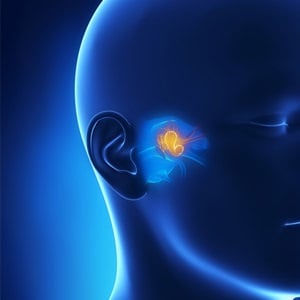
It's a relatively common cause of loss of hearing. Otosclerosis tends to run in families: if both parents have otosclerosis, the risk is 50 percent to the children. It most typically affects white women of middle age though it can manifest as early as the age of 15. Though it generally starts in one ear, it usually eventually affects both ears and may get worse during pregnancy.
It is believed that the composer Beethoven suffered from otosclerosis, as did the eccentric Howard Hughes, and the pop singer Frankie Valli. In the popular TV series CSI, the character Gil Grissom suffered from this condition, and had a successful stapedectomy.
Alternative names
Chronic conductive hearing loss; otospongiosis.
What causes it
The mechanism of hearing is this:
- Sound waves cause the ear drum to vibrate,
- Three tiny bones in the middle ear transmit these vibrations to the fluid of the inner ear, and
- There, movement of hair cells causes the nerve impulses we experience as sound.
In otosclerosis, abnormal growth of bone within the inner ear interferes with the movement of the bones, especially ones called the stapes, and thus with the transmission of the sound waves. Around 1 in 10 of people with typical bone changes actually develops significant hearing loss.
Symptoms
Gradual onset of hearing loss, often first noticed with whispers or low-pitched sounds. This loss is progressive, but variable There can also be dizziness, balance problems, or tinnitus – a ringing, hissing, or other abnormal noise heard in the ears or head.
Diagnosis
Generally, an ear, nose & throat (ENT) specialist would examine you and rule out other possible causes of similar symptoms. An audiologist might carry out various tests to assess your hearing and balance.
Treatment
Where the condition is mild, a hearing aid alone may be sufficient help.
A stapedectomy may be performed to bypass the bones which have been affected, usually inserting a tiny prosthesis to replace some of the sclerotic ( scarred ) bone. This is usually done on the worst affected ear, with the other ear being treated three to 12 months later when it is clear that the first operation was successful. The operation has a high success rate. Discuss the risks and benefits with the surgeon, as, rarely, the operation may fail to improve the hearing.
Some have used sodium fluoride which may slow the bony changes.
Prognosis
The problem tends to be progressive, but good surgical results may last for decades.
When to call your doctor
It is advisable to consult your doctor if you experience any persistent loss of hearing.
(MA Simpson, Health24, February 2008)




 Publications
Publications
 Partners
Partners











